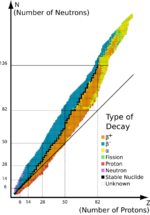Physics:Hypertriton
A hypertriton is a type of hypernucleus, formed of a proton, a neutron and any hyperon. The name comes from hyperon, which refers to baryons containing strange quarks, and triton, which refers to the nucleus of tritium. Because low-mass hyperons are longer-lived and easier to create than high-mass hyperons, the most common hypertritons are those containing Lambda baryons. Its antiparticle, the antihypertriton, is formed of an antiproton, an antineutron and any antihyperon. The first one was discovered in March 2010 by the STAR detector of the Relativistic Heavy Ion Collider (RHIC) at Brookhaven National Laboratory.
Extension of the table of nuclides
Normal nuclei are formed only of protons and neutrons. To study them, scientists arrange the various nuclides into a two-dimensional table of nuclides. On one axis is the number of neutrons N, and on the other is the number of protons Z. Because the antihyperon introduces a third component (strangeness), the table becomes three-dimensional.
Sources
- STAR Discovers the Strangest Antimatter Yet
- RHIC nets strange antimatter
- Exotic antimatter finding may clarify cosmic symmetries
This article uses only URLs for external sources. (2021) (Learn how and when to remove this template message) |
This article does not cite any external source. HandWiki requires at least one external source. See citing external sources. (2021) (Learn how and when to remove this template message) |
 |


